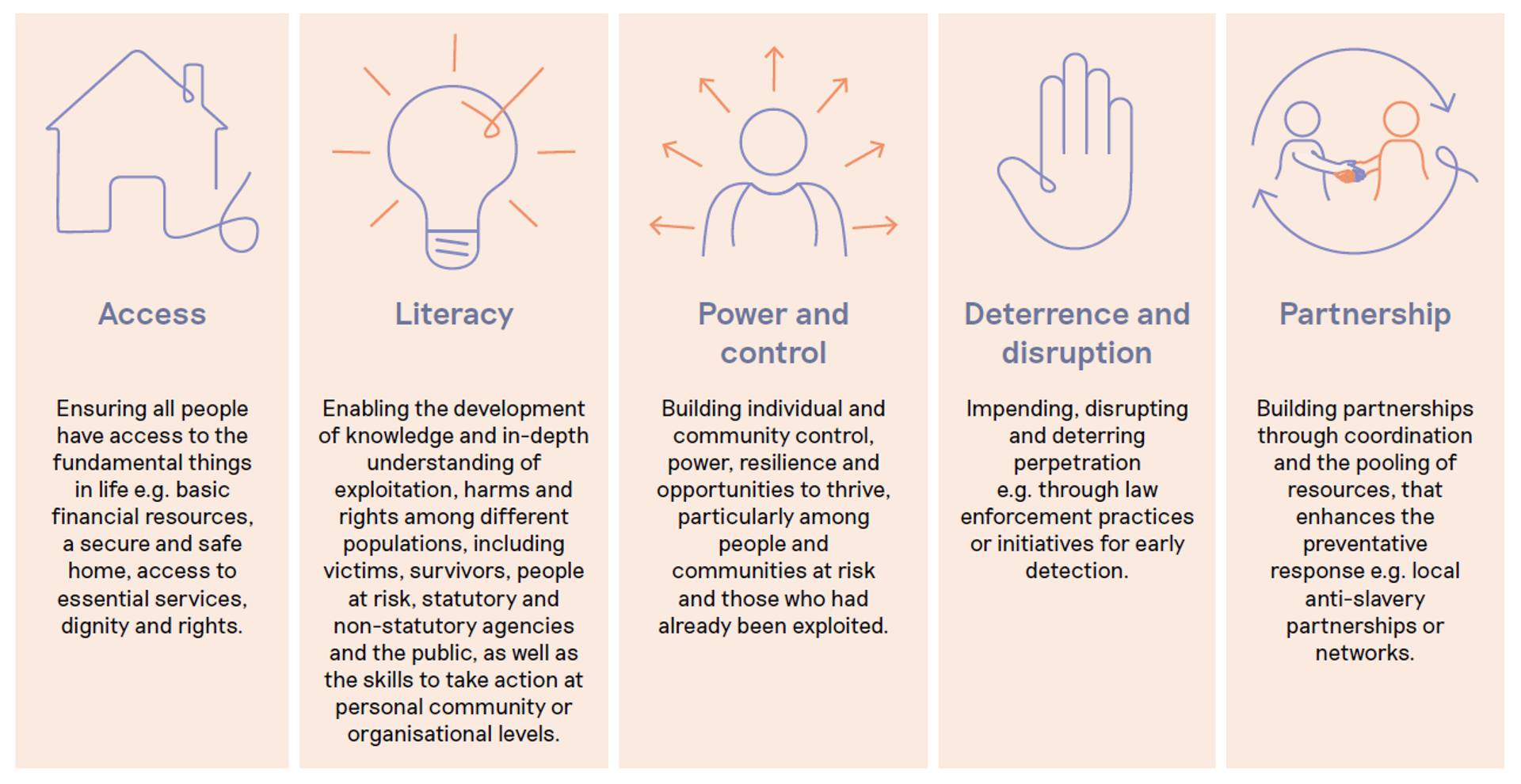This report, titled “The prevention of Adult Exploitation and Trafficking: A Synthesis of Research Commissioned by the Modern Slavery and Human Rights Policy and Evidence Centre (PEC)”, offers a comprehensive synthesis of studies commissioned by the Centre on adult exploitation and trafficking, identifying the profile of prevention in its research, the characteristics of studies, the themes of prevention-relevant research and the gaps in the evidence base.
The synthesis draws on research conducted between 2020 and 2024, organised into a public health model with prevention strategies at multiple stages: primary (before harm occurs), secondary (early intervention), and tertiary (after harm occurs) and preventing re-trafficking). This framework, known as the BETR continuum, serves as a guiding structure for categorising research findings and gaps across various studies in the PEC portfolio. The report emphasises the need for a multi-agency, system-level approach and highlights areas where prevention is under-researched, notably in primary and secondary prevention and systemic responses to prevent re-trafficking.
Lunchtime seminar
On Friday 13 December 2024 at 12.30 UK time, Dr Liz Such, the author of the study, will present the findings and consider how we could potentially reframe modern slavery prevention.
Research overview and objectives
The report’s primary purpose is to summarise and assess the PEC-funded research projects’ focus on prevention. The review covers a diverse array of studies, noting that out of the entire portfolio, only two funding call were explicitly dedicated to prevention. While the report acknowledges that almost all research in the PEC portfolio touches on prevention, it notes that the majority do so only implicitly, leaving room for clearer articulation of prevention pathways in future studies.
BETR continuum
Using evidence synthesis methods and a public health framework, the report explores the PEC studies in relation to four stages of prevention:
- Primary Prevention: Preventing exploitation before it occurs, focused on upstream social, economic, and policy measures.
- Secondary Prevention: Early intervention to stop exploitation in its initial stages.
- Tertiary Prevention: Includes addressing and treating harm after exploitation has occurred
- Preventing re-trafficking/re-exploitation.
 The BETR continuum of prevention
The BETR continuum of prevention
Key findings and themes
The synthesis identifies overarching themes within PEC-funded studies, categorised into two broad domains: the overall characteristics of the portfolio and thematic findings focused on prevention. The report notes that none of the studies defined prevention.
Limited emphasis on primary and secondary prevention
While most studies implicitly relate to prevention, explicit primary and secondary prevention studies (i.e., addressing factors that prevent exploitation before it begins and at early stages of exploitation) were underrepresented. Instead, the emphasis was placed primarily on tertiary prevention of addressing harms after they occurred. The explicit focus on re-trafficking was also scant.
This focus on post-exploitation support and survivor services underscores the need for more ‘upstream’ prevention research. The report identifies a significant need for research that addresses systemic and root causes of exploitation, which could contribute to preventing trafficking before it occurs.
Insights on missed opportunities and failures to act
A key theme across many studies was the identification of missed opportunities for early intervention. This includes gaps where professionals could have acted to mitigate exploitation risks but failed to do so, leading to exacerbated harm. Examples include:
- Missed Interventions: Missed chances to support individuals at risk, such as when in contact with health services or individuals with complex needs related to mental health or substance use.
- Gaps in Professional Training: Many professionals lacked training on identifying exploitation risks, especially outside designated victim support roles.
- Reporting and Safeguarding: Studies highlighted the need for better mechanisms for individuals to report potential exploitation, particularly in sensitive areas like sex work.
Prevention pathways
The synthesis looked at five pathways to prevention across the PEC literature, including enabling access to the fundamental aspects of life, developing literacy, building power and control, deterrence and disruption, and partnerships. [include graphic]
However, it found that while these pathways were often implied in the studies, they were rarely articulated or modelled as distinct strategies within prevention efforts. Recommendations include making prevention pathways explicit in research to improve clarity and application for future studies and interventions.
 Five prevention pathways
Five prevention pathways
Primary prevention in governance of trade and finance
Four studies addressed how trade and investment governance can contribute to preventing exploitation through supply chain regulation, corporate responsibility, and social auditing. For example:
- Supply Chain and Investor Practices: Studies showed that ethical divestment and disengagement from products linked to forced labour, like Uyghur labour in certain regions, could prevent exploitation before it happens..
- Contract Monitoring and Enforcement: Evidence suggested that without strict monitoring, contractual measures could become mere administrative requirements without meaningful impact. For instance, social contractual clauses in Pakistan improved child labour outcomes when actively monitored.
In both of these areas of primary prevention, further evaluation of effectiveness is needed,
Tertiary prevention and survivor protection
Tertiary prevention efforts are well represented in the portfolio, with significant focus on survivor care, support, and rehabilitation. Key areas include:
- Secure and Suitable Housing: Ensuring survivors have stable, safe housing to prevent re-exploitation is critical. Housing standards and access were seen as protective factors for preventing future harm.
- Trauma-Informed Services: Providing compassionate, trauma-informed care emerged as essential for recovering from harms and preventing re-trafficking. However, barriers to access remain due to stigmatisation, bureaucracy, and cultural incompetence within service delivery.
- Multi-Agency Coordination: Studies identified multi-agency collaboration as essential to prevent re-trafficking and ensure survivors receive comprehensive support across health, housing, and criminal justice sectors.
Gaps in the evidence base and recommendations
The synthesis reveals several critical gaps in the existing evidence base and proposes recommendations to address these. The report identifies the need for greater emphasis on primary prevention and explicit theories of change to frame prevention strategies. Among the 16 specific recommendations are calls to:
- Frame Prevention in Research Calls: Encourage research that explicitly defines and addresses prevention to create a clearer evidence base.
- Diversify Prevention Pathways: Beyond trade and investment governance, the PEC should explore other primary prevention pathways, such as community-based initiatives, power and control models, and educational interventions.
- Promote Trust-Building Interventions: Recognising that stigma can deter victims from seeking help, the report suggests research and policy development for trust-building initiatives as preventative strategies.
- Systematise Multi-Agency Work: Effective multi-agency coordination and ethical data sharing are essential for cohesive prevention systems, particularly at critical transition points, such as moving from child to adult services.
- Develop Models to Address Prevention System Failures: Prevention failures appear to be systemic, spanning legal, social, and institutional barriers. Understanding these systems could support improved prevention strategies across different types of exploitation.
Prevention inequities and system-level considerations
The report also highlights potential inequities in how preventive measures are applied across various populations. It emphasises the importance of culturally competent services, especially for marginalised groups who face higher risks of exploitation.
Final recommendations and suggested actions
The report concludes with overarching suggestions to enhance prevention research, policy, and practice within the PEC portfolio and beyond. Key suggestions include fostering a prevention-oriented portfolio, focusing on research that synthesises systemic failures and successes in multi-agency prevention models, and incorporating lived experiences of survivors into research and policy-making. This includes:
- Investing in Research Addressing Root Causes: Addressing economic and social root causes of exploitation through preventive research in diverse contexts can help mitigate vulnerabilities that contribute to trafficking.
- Implement Anti-Stigma and Anti-Shame Interventions: Interventions that reduce stigma and encourage help-seeking behaviour among vulnerable populations, including legal sex workers and migrant communities, could enhance early detection and reporting.
- Build a Compendium of Multi-Agency Practices: Collecting effective multi-agency strategies for preventing exploitation across different forms can serve as a valuable resource for policymakers and practitioners.
Overall, the report underscores the need for more targeted and systematised prevention frameworks to address adult exploitation and trafficking. By building a stronger evidence base, particularly around primary and early prevention, and improving multi-agency coordination, the PEC portfolio can provide more actionable insights and tools to prevent trafficking and exploitation in a systemic, sustainable manner.





